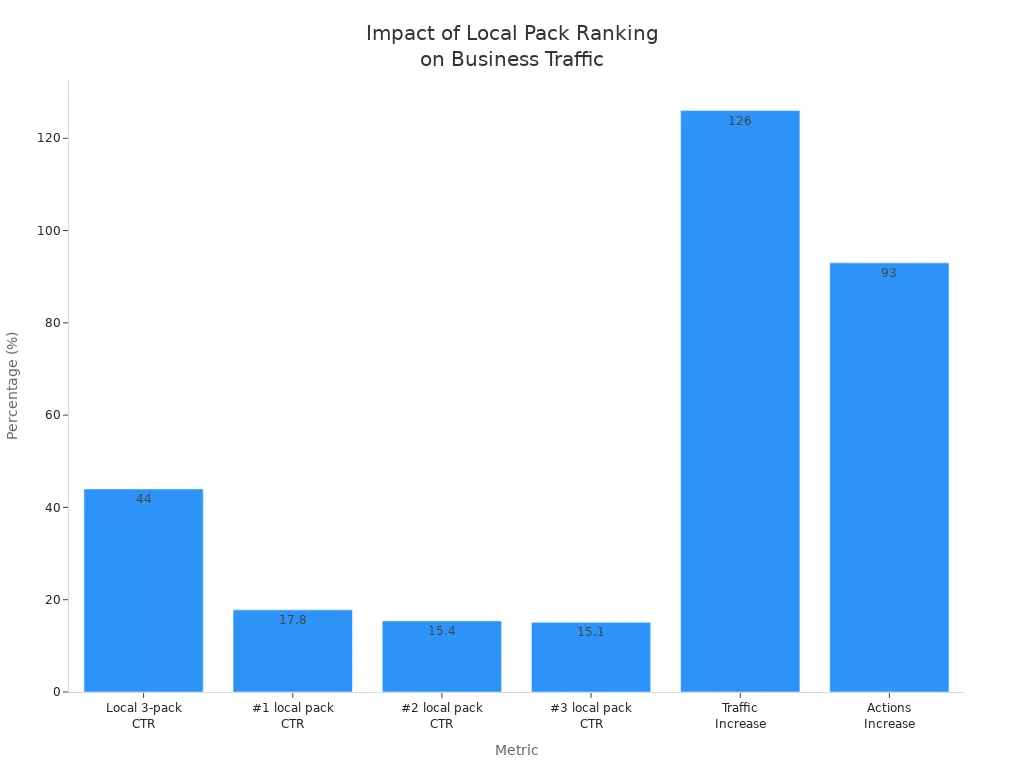Step-by-Step Guide to Local SEO Competition Analysis

Analyzing local SEO competition helps you improve rankings and stand out in local search. When you study competitor research, you discover how businesses use local keywords and optimize google my business profiles. This local competitive analysis reveals tactics that drive more physical visits, attract targeted web traffic, and build trust. You can develop a stronger local SEO strategy by learning what works in your market area. Understanding these methods leads to lasting growth and gives your business a real edge.
Identify Local Competitors

Define Market Area
You need to start your local SEO competition analysis by defining your market area. Think about the neighborhoods, cities, or regions where your business operates. This step helps you focus your competitor research on businesses that matter most in your local search results. The CSIS method offers a smart way to spot real local competitors in crowded markets. It uses a special type of regression to find which businesses compete with you directly. This method works well even when many businesses are nearby. By knowing your market area, you can build a strong local SEO strategy that targets the right audience.
Find Competitors on Google
Next, you should find real local competitors using Google. Open an Incognito window and search for local keywords that your customers might use. Look at the local pack and organic results. You will see which businesses show up most often in local search. These are your main competitors. Make a list of them. You can also use Google My Business to check how other businesses set up their profiles. This gives you ideas for your own local competitive analysis.
Tip: Try searching different keywords and locations to see how the results change. This helps you spot more real local competitors.
List Direct and Indirect Competitors
After you find businesses on Google, you need to list both direct and indirect competitors. Direct competitors offer the same products or services as you in your market area. Indirect competitors may sell something different but still attract your customers. Check social media and local directories for more competitor research. You can find businesses that do not show up in Google but still matter in local search. Make a table to organize your findings:
| Competitor Name | Type | Location | Google My Business Presence |
|---|---|---|---|
| Example Biz 1 | Direct | Downtown | Yes |
| Example Biz 2 | Indirect | Uptown | No |
This list helps you see the full picture of your local SEO competition. You can use it to guide your local SEO strategy and improve your local search rankings.
Local SEO Competition Analysis
Review Google My Business Profiles
You need to start your local SEO competition analysis by looking closely at google my business profiles. This step helps you see what makes top competitors stand out in local search. Focus on these key elements:
- Reviews: Check the total number of reviews and the average star rating. These numbers can boost a business’s spot in local search.
- Duplicates: Look for duplicate listings. Duplicates can confuse customers and lower rankings.
- NAP Consistency: Make sure the name, address, and phone number match across all listings.
- Categories: Review the business categories. Accurate categories help google my business show the right results.
- Website Links: See if the linked website is strong and relevant.
- Business Hours: Confirm that business hours are correct. Wrong hours can hurt visibility.
When you use these points in your competitor research, you can spot gaps and improve your own google my business profile.
Check Local Pack Rankings
The local pack is the group of three businesses that show up at the top of local search results. Getting into this pack can bring a big jump in website visits and calls. Recent studies show how much local pack rankings matter:
| Statistic | Value |
|---|---|
| Local 3-pack click-through rate | 44% |
| Click-through rate for #1 local pack result | 17.8% |
| Click-through rate for #2 local pack result | 15.4% |
| Click-through rate for #3 local pack result | 15.1% |
| Increased traffic for businesses in local pack | 126% |
| Increased actions for businesses in local pack | 93% |

You should check which businesses appear in the local pack for your main local keywords. This step gives you a clear view of your local seo competition and helps you shape your local seo strategy.
Note: Customers are 70% more likely to visit businesses with a complete google my business profile. About 68% of people prefer businesses that show up in the map pack.
Monitor Local Search Performance
Tracking your local search performance helps you see how you stack up against competitors. Use tools like Local Falcon for local rank tracking and AI analysis. This tool shows your position in local search and helps you explain results to your team. BrightLocal also gives you insights into your competitors’ local search performance. It shows not just where you rank, but also why others may do better.
Regular monitoring lets you adjust your local competitive analysis and competitor research. You can spot trends, fix weak spots, and keep your business strong in local search.
Analyze Keyword Strategies

Identify Competitor Keywords
You need to know which local keywords your competitors use. Start by searching your main services or products in local search. Look at the top results. Write down the words and phrases that appear often in titles, meta descriptions, and headings. These keywords help you understand what attracts customers in your area. You can use competitor research to spot patterns and find gaps in your own local seo strategy. If you see a keyword that brings many visitors to a competitor, try using it on your website.
Tip: Check reviews and Q&A sections on Google My Business profiles. Customers often use important keywords when they ask questions or leave feedback.
Use SEMrush and Ahrefs
You can use tools like SEMrush and Ahrefs to dig deeper into keyword strategies. SEMrush works well for local search because it tracks rankings at the city level. It also updates rank tracking every day. Ahrefs has a bigger keyword database and covers more locations, but it does not track local rankings as closely. SEMrush offers more keyword variations for the USA, which helps you find new ideas for your local competitive analysis.
| Feature | SEMrush | Ahrefs |
|---|---|---|
| Local Tracking | Excels in local tracking capabilities | Lacks local tracking at the city level |
| Keyword Database Size | 27.3 billion keywords in 142 locations | 28.7 billion keywords in 217 locations |
| Keyword Variations in USA | More keyword variations for the USA | Fewer keyword variations in the USA |
| Rank Tracking Updates | Daily updates available | Paid feature, not included in free tools |
| Overall Accuracy | Better for rank tracking | Inaccuracies reported in organic performance |
If you want to improve your local seo competition, use SEMrush for tracking and Ahrefs for finding new keywords. Both tools help you build a strong local seo strategy.
Review On-Page Keyword Usage
Check how your competitors use local keywords on their websites. Look at homepage content, service pages, and blog posts. See if they use keywords in headings, image alt text, and internal links. Good keyword placement helps businesses show up in local search. You can learn from their tactics and improve your own pages. Make a list of pages that rank well and study how they use keywords. This step helps you boost your local search visibility and stay ahead in competitor research.
Note: Use keywords naturally. Do not stuff them into your content. Search engines reward clear and helpful writing.
Assess Citations and NAP Consistency
Check Directory Listings
You need to check your directory listings to build strong local citations. Start by searching for your business on popular platforms. These listings help search engines confirm your business details and improve your local search visibility. Both structured citations, like those on Yelp and Tripadvisor, and unstructured citations, such as mentions on blogs or news sites, play a role in your local seo strategy. You should focus on the most authoritative directories for local citations. Here is a table showing some of the top options:
| Directory Name | Type |
|---|---|
| Google Business Profile | General |
| Yelp | General |
| Yellow Pages | General |
| Tripadvisor | Industry-Specific |
| Healthgrades | Industry-Specific |
| Bing Places for Business | General |
| Better Business Bureau | General |
| ChamberofCommerce.com | General |
| Foursquare | General |
Tip: Claim and update your listings on these directories to strengthen your local search presence and stay ahead in local seo competition.
Compare Citation Quality
You should compare the quality of your local citations with those of your competitors. High-quality citations come from trusted directories and websites. If you see your competitors listed on more authoritative platforms, you may need to improve your own local citations. Experts say that while local citations are essential for local search rankings, their importance as a ranking signal is decreasing each year. Behavioral SEO factors now play a bigger role. A strong citation profile is still necessary for local competitive analysis, but adding more citations does not always boost rankings if you already have a solid foundation.
- Structured citations appear on formal directories.
- Unstructured citations show up on blogs and news sites.
- Both types help your business get noticed in local search.
Review NAP Consistency
NAP stands for Name, Address, and Phone number. You must keep this information consistent across all your local citations. Inconsistent NAP data can confuse users and search engines. This confusion can lower your visibility in local search results. Accurate NAP details build credibility and trust. Research shows that businesses with consistent NAP information rank higher in local search and look more professional to customers.
| Impact of NAP Consistency on Local SEO | Description |
|---|---|
| Visibility | Inconsistent NAP data can confuse users and search engines, leading to reduced visibility in local searches. |
| Credibility | Discrepancies in contact details may damage a business's reputation, causing potential customers to question its professionalism. |
| Search Engine Rankings | Accurate and consistent NAP information increases trustworthiness, which can lead to higher rankings in local search results. |
Note: Review your local citations regularly to make sure your NAP details match everywhere. This step supports your local seo strategy and helps you stay competitive in local search.
Evaluate Website and On-Page SEO
Review Homepage Content
Your homepage acts as the front door for your business online. When you want to improve your local search rankings, you need to make sure your homepage includes the right elements. Top-ranking local business websites often show primary calls-to-action above the fold. You see secondary CTAs further down the page to keep visitors interested. Key features of your products or services should appear clearly. A resourceful footer helps visitors explore and learn more. Customer success stories and awards build trust and credibility. If your site has lots of content, a search bar makes navigation easier. You also need an easy-to-find 'Contact Us' option so people can reach you quickly.
- Primary calls-to-action above the fold
- Secondary CTAs to keep visitors engaged
- Clear listing of key features
- Resourceful footer for exploration
- Customer success stories and awards
- Search bar for content-heavy sites
- Accessible 'Contact Us' options
These elements help you stand out in local search and support your local seo strategy.
Analyze Local Landing Pages
Local landing pages play a big role in your local competitive analysis. You create these pages to target specific keywords that matter for your business. Search engines use these pages to match your content with local search queries. When you guide visitors with clear information, you improve their experience and increase conversion rates. Optimized landing pages send strong local SEO signals. They help you rank higher in local search by offering relevant and quality content.
- Targeted content for local keywords
- Better user experience and engagement
- Enhanced local SEO signals for higher rankings
You should review your landing pages and make sure they match what people in your area are searching for.
Check Schema Markup
Schema markup helps search engines understand your website better. You add special code to your pages that shows details like your business name, address, phone number, and hours. When you use schema markup, you make it easier for search engines to show your business in local search results. You can check your competitors’ websites to see if they use schema markup. If you find gaps, you can improve your own site and get ahead in local competitive analysis. Schema markup supports your local seo strategy and helps you appear more often in local search.
Tip: Use Google’s Structured Data Testing Tool to check your schema markup and fix any errors.
Examine Reviews and Reputation
Review Quantity and Quality
You should pay close attention to the number and quality of reviews your business receives. Online reviews play a big role in local search rankings. Search engines like Google look for fresh reviews because they show that your business is active and customers care about your services. A steady stream of positive reviews helps your business look trustworthy. When customers use keywords in their reviews, your visibility in local search can improve even more.
- A higher number of reviews boosts your spot in search results.
- Fresh reviews show ongoing customer engagement.
- Reviews with important keywords help your business get noticed.
Think of reviews as flowers that attract bees. Each positive review adds to your online presence and helps you climb higher in local search results.
Assess Response Strategies
You need to respond to all customer reviews, both good and bad. This shows that you care about feedback and want to build strong relationships. When you engage with your community, you build trust and make your business stand out in local search. Social media gives you a fast way to reply to feedback and turn critics into supporters.
| Strategy | Description |
|---|---|
| Responding to all customer reviews | Strengthens relationships and shows attentiveness to feedback. |
| Engaging in community initiatives | Builds local presence and fosters trust within the community. |
| Leveraging social media | Enhances visibility and allows for rapid response to feedback. |
Quick and thoughtful responses help you manage your reputation and improve your results in local competitive analysis.
Identify Reputation Tactics
Top local businesses use smart tactics to manage their reputation. You should learn from these strategies to boost your own local search performance.
| Tactic | Description |
|---|---|
| Local SEO | Enhances visibility in local searches, crucial for attracting nearby customers. |
| Social Media Management | Uses platforms like Facebook and LinkedIn to engage with customers and manage reputation. |
| Online Review Management | Creates strategies to encourage positive reviews and handle negative feedback effectively. |
| Public Relations | Builds positive relationships and improves online visibility through strategic communication. |
| Reputation Monitoring | Watches online mentions and reviews to spot potential threats early. |
Almost all consumers check small businesses online before making a purchase. You should monitor your reputation and use these tactics to stay ahead in local search. Strong reputation management supports your local competitive analysis and helps you attract more customers.
Investigate Backlinks
Review Backlink Quality
You need to check the quality of backlinks pointing to your website. High-quality backlinks help you rank better in local search. You can use metrics to measure backlink strength. The table below shows important metrics you should consider:
| Metric | Description |
|---|---|
| Domain Authority (DA) | Predicts how well a website ranks on search engines. Higher scores mean better ranking power. |
| Page Authority (PA) | Measures the ranking strength of a specific page. |
| Traffic of Referring Domain | Shows if the linking site gets many visitors. More traffic means more value for your link. |
| Trustworthiness of Domain | Trusted sites have good content and a strong reputation. |
You should also look for links from websites that are local or related to your industry. These links can boost your local search rankings.
Find Local and Industry Links
Links from local sources and industry websites tell search engines that your business matters in your area. These backlinks help you stand out in local search. The table below explains how different types of links affect your rankings:
| Evidence Description | Relevance to Query |
|---|---|
| Local SEO backlinks signal authority and relevance for specific areas. | They enhance local search rankings by showing local credibility. |
| Links from authoritative, non-local sites can help local search results. | Even non-local links can improve your local search visibility. |
| Backlinks from local news websites improve local SEO. | They boost both local and business relevance in local search. |
| Domain authority is important for backlink quality. | High DA is good, but local relevance is key for local search. |
| Strategic anchor text in backlinks creates strong results. | It signals relevance to search engines for local search. |
You should try to get links from local news sites, business directories, and industry blogs. These links show your business is active in the community and trusted by others.
Spot Link Opportunities
You can find new backlink opportunities by looking at where your competitors get their links. Follow these steps to improve your local search presence:
- Analyze your competitors’ backlinks using tools like Ahrefs or SEMrush.
- Create high-quality content that highlights your expertise and involvement in the community.
- Build relationships with local businesses and organizations for new link opportunities.
You should also make sure your business appears in trusted online directories. When you focus on local and industry-specific links, you strengthen your position in local search and attract more customers.
Summarize Insights and Next Steps
Highlight Key Findings
You have learned many important things from your local SEO competition analysis. These insights help you understand your market and improve your strategy.
- You see your competitors’ strengths and weaknesses.
- You find gaps in your own approach.
- You discover successful tactics that boost local search visibility.
You also identify direct and indirect competitors for your main keywords and categories. You compare local rankings in Google for your core search queries. You review Google My Business profiles and metrics to see what works best.
Tip: Use these findings to guide your next steps and make smart decisions for your business.
Prioritize Improvements
You need to decide which changes will help your business the most. Start by looking at your competitors’ strengths and weaknesses. Spot gaps in the market by reading customer feedback and studying competitor actions.
- Focus on areas where your business can improve quickly.
- Look for chances to innovate by fixing problems found in reviews.
- Use professional benchmarking to check pricing, product choices, and customer retention.
- Plan marketing strategies that set you apart from others.
A simple table can help you organize your priorities:
| Improvement Area | Reason for Priority | Expected Benefit |
|---|---|---|
| Website Performance | Slow site compared to others | Faster user experience |
| Review Management | Fewer reviews than peers | Higher trust |
| Local Landing Pages | Missing for some locations | Better local rankings |
Create Action Plan
You can turn your insights into action by following clear steps.
- Optimize your website design and speed.
- Collect and study online reviews.
- Research competitors often to stay updated.
- Build location-specific landing pages for each area you serve.
Note: Review your progress every month. Adjust your plan as you learn more about your competitors and your own results.
You will see steady growth in your local search rankings when you follow these steps and keep improving.
You improve your local search rankings when you analyze competitors and update your strategy often. Businesses that stop collecting reviews or updating their profiles lose visibility in just weeks. Regular monitoring with tools like Whitespark and Citation Finder helps you find new citation opportunities and stay ahead.
| Tool | Benefit |
|---|---|
| Whitespark | Builds local authority |
| Citation Finder | Reveals competitor citation platforms |
Track your progress using Google Search Console, Google Analytics, and real-time dashboards. Keep learning from your competitors and adjust your plan to maintain strong local SEO results.
FAQ
What is local SEO competition analysis?
Local SEO competition analysis helps you study other businesses in your area. You learn what keywords they use, how they rank, and what makes them successful. This process helps you improve your own local search results.
How often should you check your competitors?
You should check your competitors every month. Regular checks help you spot changes in their strategies. You can adjust your own plan to stay ahead in local search.
Which tools help with local SEO analysis?
You can use SEMrush, Ahrefs, BrightLocal, and Whitespark. These tools show keyword rankings, backlinks, and citation sources. They help you track your progress and find new opportunities.
Why does NAP consistency matter?
NAP stands for Name, Address, and Phone number. Search engines trust businesses with matching details everywhere. Consistent NAP helps you rank higher and builds trust with customers.
Can reviews affect your local search ranking?
Yes, reviews play a big role. More positive reviews help you move up in search results. Fresh reviews show that your business is active and trusted by customers.
See Also
Step-By-Step SEO Audit Guide in 14 Easy Steps
Essential SEO Strategies for New Startups Explained
Effective Content Writing Tools to Boost Your SEO Ranking
Building Authentic SEO Strategies with Link Exchange Techniques
Understanding SEO: An In-Depth Look at Optimization Techniques

